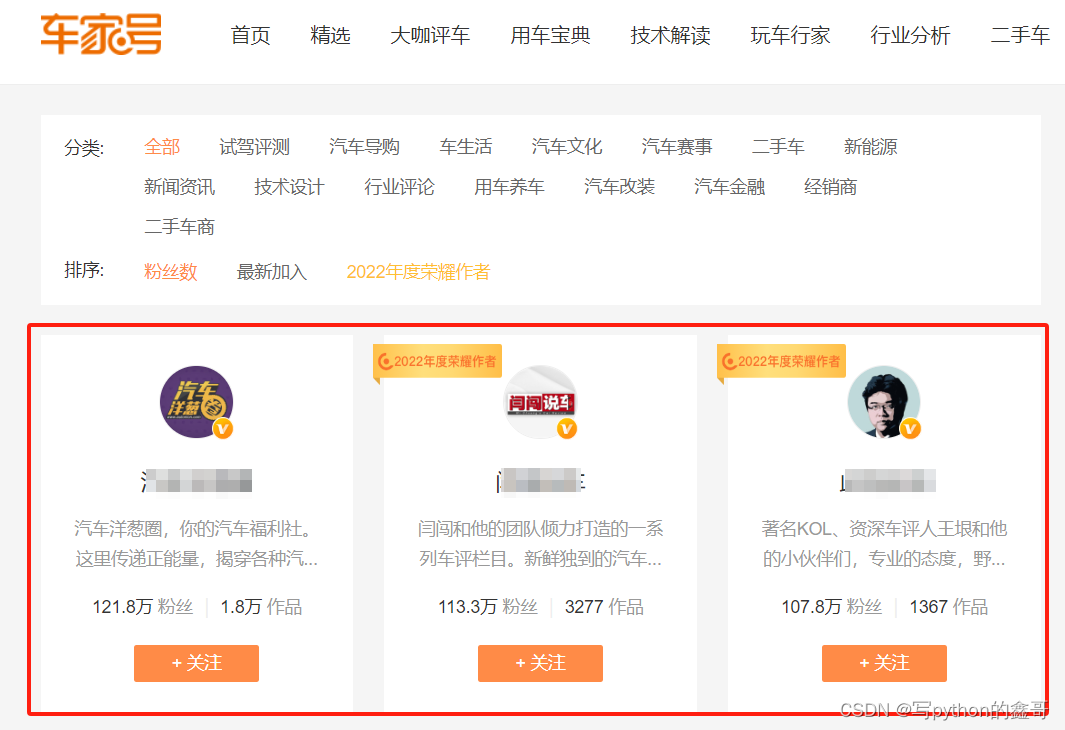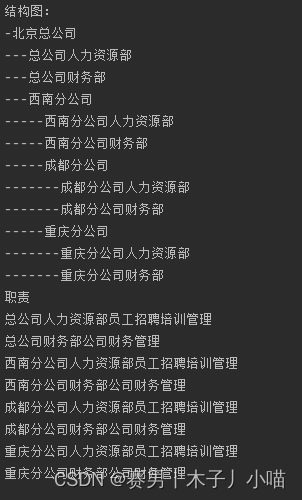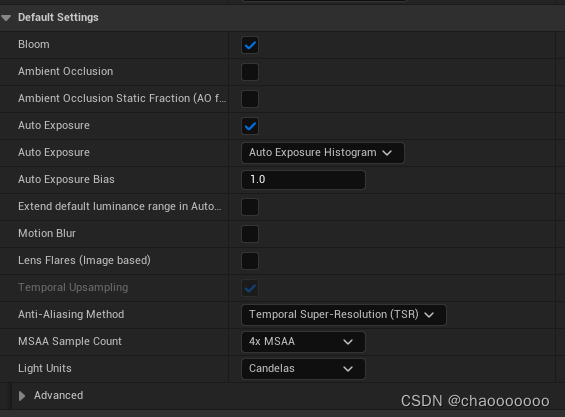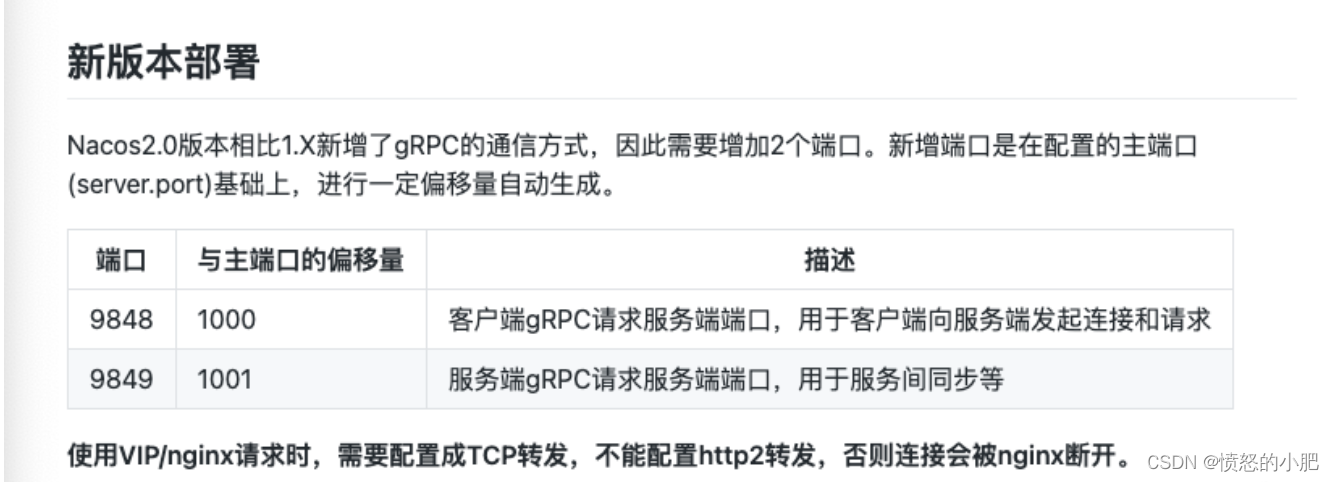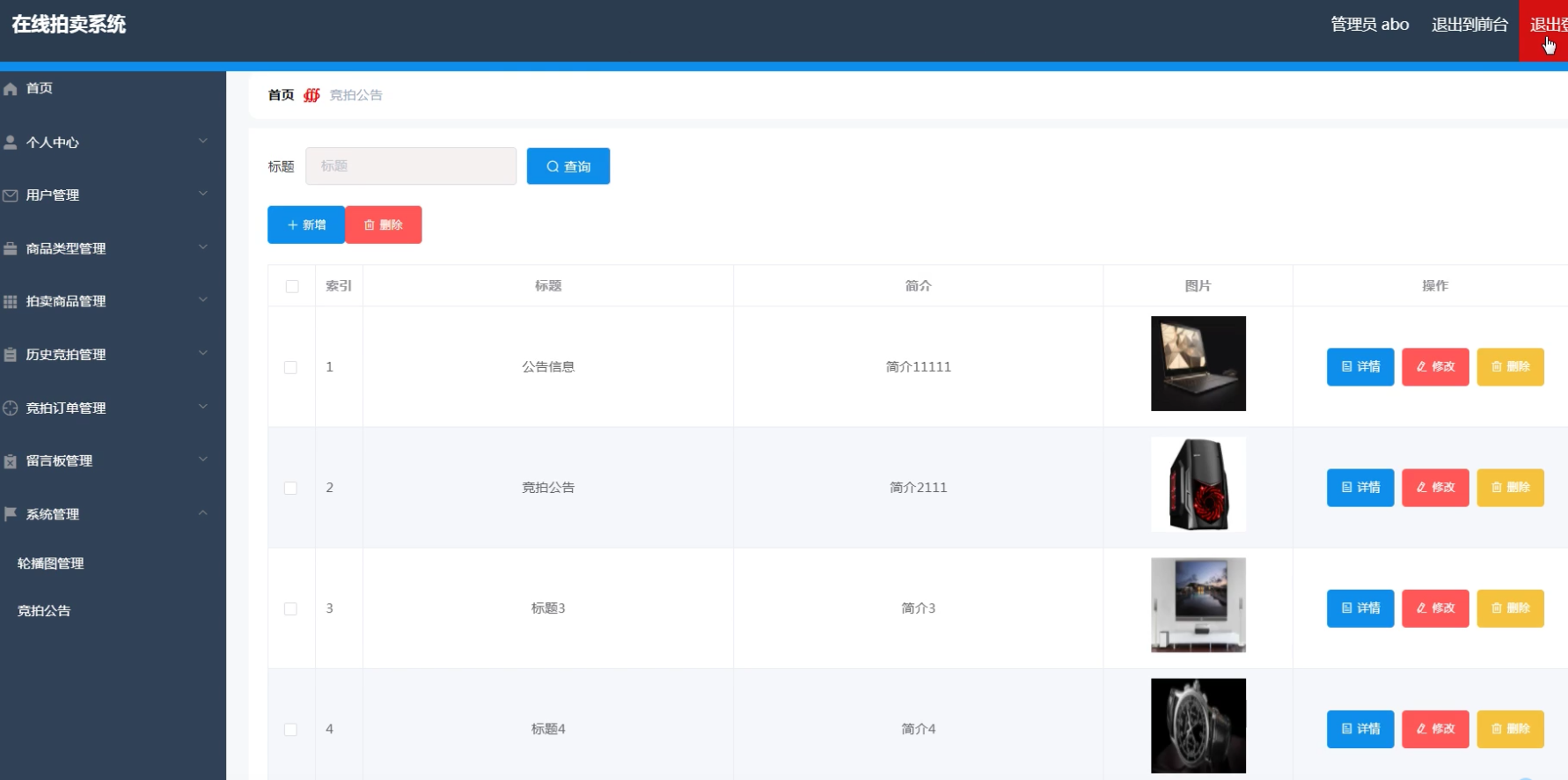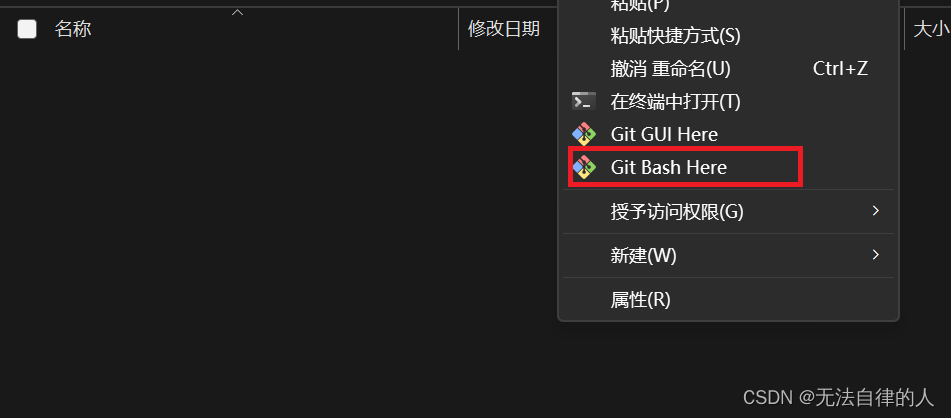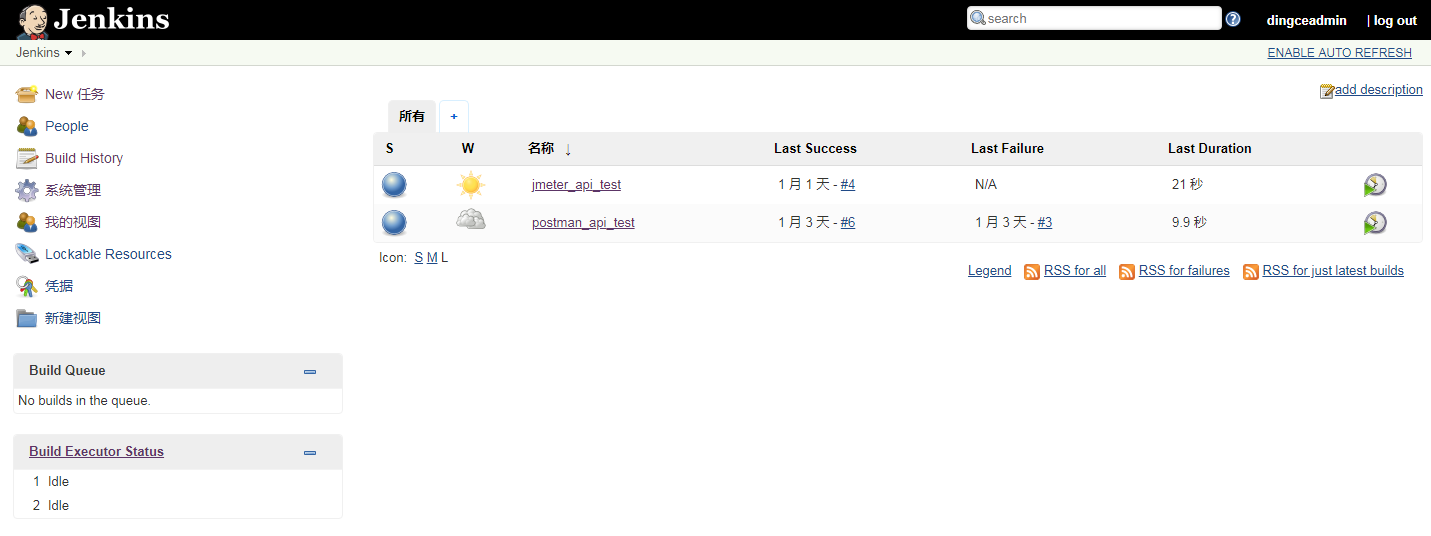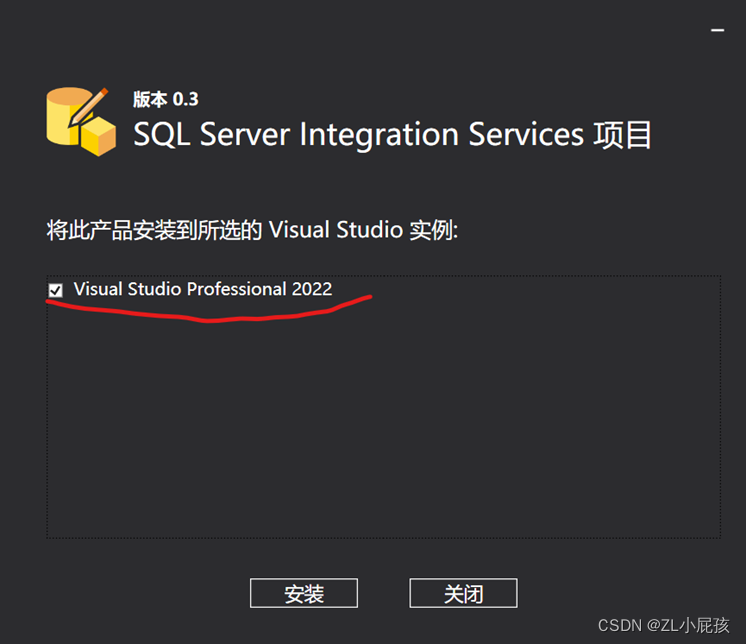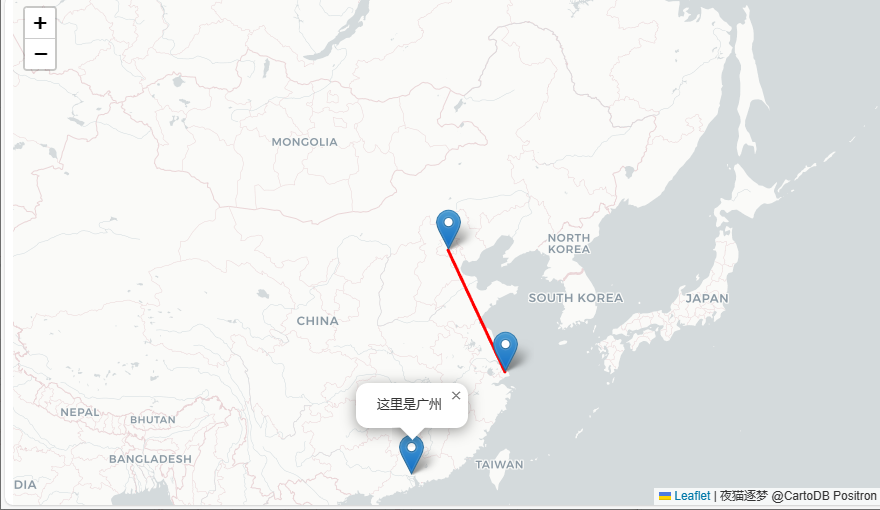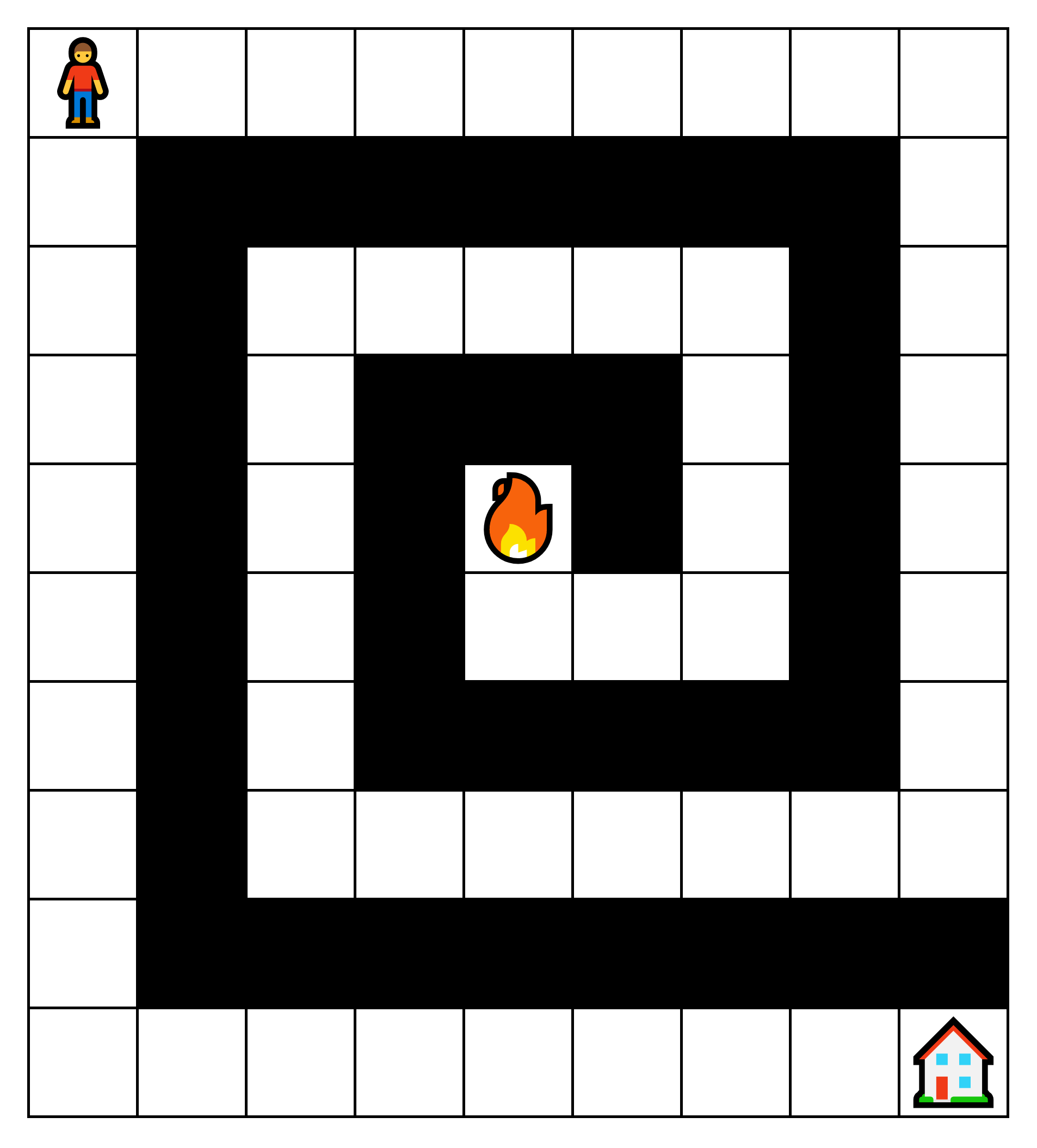三、Spring Data JPA概述
Spring Data JPA 是 Spring 基于 ORM 框架、JPA 规范的基础上封装的一套JPA应用框架,可使开发者用极简的代码即可实现对数据库的访问和操作。它提供了包括增删改查等在内的常用功能,且易于扩展!学习并使用 Spring Data JPA 可以极大提高开发效率!
Spring Data JPA 让我们解脱了DAO层的操作,基本上所有CRUD都可以依赖于它来实现,在实际的工作工程中,推荐使用Spring Data JPA + ORM(如:hibernate)完成操作,这样在切换不同的ORM框架时提供了极大的方便,同时也使数据库层操作更加简单,方便解耦
3.1 Spring Data JPA的特性
SpringData Jpa 极大简化了数据库访问层代码。 如何简化的呢? 使用了SpringDataJpa,我们的dao层中只需要写接口,就自动具有了增删改查、分页查询等方法。
3.2 Spring Data JPA 与 JPA和hibernate之间的关系
JPA是一套规范,内部是有接口和抽象类组成的。
hibernate是一套成熟的ORM框架,而且Hibernate实现了JPA规范,所以也可以称hibernate为JPA的一种实现方式,我们使用JPA的API编程,意味着站在更高的角度上看待问题(面向接口编程)
Spring Data JPA是Spring提供的一套对JPA操作更加高级的封装,是在JPA规范下的专门用来进行数据持久化的解决方案。
四、Spring Data JPA入门案例
4.1 搭建Spring Data JPA的开发环境
代码结构如下:
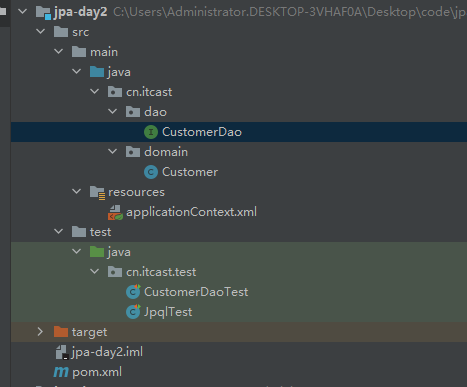
4.1.1 引入Spring Data JPA的坐标
使用Spring Data JPA,需要整合Spring与Spring Data JPA,并且需要提供JPA的服务提供者hibernate,所以需要导入spring相关坐标,hibernate坐标,数据库驱动坐标等
pom.xml
<?xml version="1.0" encoding="UTF-8"?>
<project xmlns="http://maven.apache.org/POM/4.0.0"
xmlns:xsi="http://www.w3.org/2001/XMLSchema-instance"
xsi:schemaLocation="http://maven.apache.org/POM/4.0.0 http://maven.apache.org/xsd/maven-4.0.0.xsd">
<modelVersion>4.0.0</modelVersion>
<groupId>cn.itcast</groupId>
<artifactId>jpa-day2</artifactId>
<version>1.0-SNAPSHOT</version>
<properties>
<spring.version>5.0.2.RELEASE</spring.version>
<hibernate.version>5.0.7.Final</hibernate.version>
<slf4j.version>1.6.6</slf4j.version>
<log4j.version>1.2.12</log4j.version>
<c3p0.version>0.9.1.2</c3p0.version>
<mysql.version>8.0.28</mysql.version>
</properties>
<dependencies>
<!-- junit单元测试 -->
<dependency>
<groupId>junit</groupId>
<artifactId>junit</artifactId>
<version>4.12</version>
<scope>test</scope>
</dependency>
<!-- spring beg -->
<dependency>
<groupId>org.aspectj</groupId>
<artifactId>aspectjweaver</artifactId>
<version>1.6.8</version>
</dependency>
<dependency>
<groupId>org.springframework</groupId>
<artifactId>spring-aop</artifactId>
<version>${spring.version}</version>
</dependency>
<dependency>
<groupId>org.springframework</groupId>
<artifactId>spring-context</artifactId>
<version>${spring.version}</version>
</dependency>
<dependency>
<groupId>org.springframework</groupId>
<artifactId>spring-context-support</artifactId>
<version>${spring.version}</version>
</dependency>
<!-- spring对orm框架的支持包-->
<dependency>
<groupId>org.springframework</groupId>
<artifactId>spring-orm</artifactId>
<version>${spring.version}</version>
</dependency>
<dependency>
<groupId>org.springframework</groupId>
<artifactId>spring-beans</artifactId>
<version>${spring.version}</version>
</dependency>
<dependency>
<groupId>org.springframework</groupId>
<artifactId>spring-core</artifactId>
<version>${spring.version}</version>
</dependency>
<!-- spring end -->
<!-- hibernate beg -->
<dependency>
<groupId>org.hibernate</groupId>
<artifactId>hibernate-core</artifactId>
<version>${hibernate.version}</version>
</dependency>
<dependency>
<groupId>org.hibernate</groupId>
<artifactId>hibernate-entitymanager</artifactId>
<version>${hibernate.version}</version>
</dependency>
<dependency>
<groupId>org.hibernate</groupId>
<artifactId>hibernate-validator</artifactId>
<version>5.2.1.Final</version>
</dependency>
<!-- hibernate end -->
<!-- c3p0 beg -->
<dependency>
<groupId>c3p0</groupId>
<artifactId>c3p0</artifactId>
<version>${c3p0.version}</version>
</dependency>
<!-- c3p0 end -->
<!-- log end -->
<dependency>
<groupId>log4j</groupId>
<artifactId>log4j</artifactId>
<version>${log4j.version}</version>
</dependency>
<dependency>
<groupId>org.slf4j</groupId>
<artifactId>slf4j-api</artifactId>
<version>${slf4j.version}</version>
</dependency>
<dependency>
<groupId>org.slf4j</groupId>
<artifactId>slf4j-log4j12</artifactId>
<version>${slf4j.version}</version>
</dependency>
<!-- log end -->
<dependency>
<groupId>mysql</groupId>
<artifactId>mysql-connector-java</artifactId>
<version>${mysql.version}</version>
</dependency>
<!-- spring data jpa 的坐标-->
<dependency>
<groupId>org.springframework.data</groupId>
<artifactId>spring-data-jpa</artifactId>
<version>1.9.0.RELEASE</version>
</dependency>
<dependency>
<groupId>org.springframework</groupId>
<artifactId>spring-test</artifactId>
<version>${spring.version}</version>
</dependency>
<!-- el beg 使用spring data jpa 必须引入 -->
<dependency>
<groupId>javax.el</groupId>
<artifactId>javax.el-api</artifactId>
<version>2.2.4</version>
</dependency>
<dependency>
<groupId>org.glassfish.web</groupId>
<artifactId>javax.el</artifactId>
<version>2.2.4</version>
</dependency>
<!-- el end -->
</dependencies>
</project>
4.1.2 整合Spring Data JPA与Spring
resources/applicationContext.xml
<?xml version="1.0" encoding="UTF-8"?>
<beans xmlns="http://www.springframework.org/schema/beans"
xmlns:xsi="http://www.w3.org/2001/XMLSchema-instance" xmlns:aop="http://www.springframework.org/schema/aop"
xmlns:context="http://www.springframework.org/schema/context"
xmlns:jdbc="http://www.springframework.org/schema/jdbc" xmlns:tx="http://www.springframework.org/schema/tx"
xmlns:jpa="http://www.springframework.org/schema/data/jpa" xmlns:task="http://www.springframework.org/schema/task"
xsi:schemaLocation="
http://www.springframework.org/schema/beans http://www.springframework.org/schema/beans/spring-beans.xsd
http://www.springframework.org/schema/aop http://www.springframework.org/schema/aop/spring-aop.xsd
http://www.springframework.org/schema/context http://www.springframework.org/schema/context/spring-context.xsd
http://www.springframework.org/schema/jdbc http://www.springframework.org/schema/jdbc/spring-jdbc.xsd
http://www.springframework.org/schema/tx http://www.springframework.org/schema/tx/spring-tx.xsd
http://www.springframework.org/schema/data/jpa
http://www.springframework.org/schema/data/jpa/spring-jpa.xsd">
<!--spring 和 spring data jpa的配置-->
<!-- 1.创建entityManagerFactory对象交给spring容器管理-->
<bean id="entityManagerFactoty" class="org.springframework.orm.jpa.LocalContainerEntityManagerFactoryBean">
<property name="dataSource" ref="dataSource" />
<!--配置的扫描的包(实体类所在的包) -->
<property name="packagesToScan" value="cn.itcast.domain" />
<!-- jpa的实现厂家 -->
<property name="persistenceProvider">
<bean class="org.hibernate.jpa.HibernatePersistenceProvider"/>
</property>
<!--jpa的供应商适配器 -->
<property name="jpaVendorAdapter">
<bean class="org.springframework.orm.jpa.vendor.HibernateJpaVendorAdapter">
<!--配置是否自动创建数据库表 -->
<property name="generateDdl" value="false" />
<!--指定数据库类型 -->
<property name="database" value="MYSQL" />
<!--数据库方言:支持的特有语法 -->
<property name="databasePlatform" value="org.hibernate.dialect.MySQLDialect" />
<!--是否显示sql -->
<property name="showSql" value="true" />
</bean>
</property>
<!--jpa的方言 :高级的特性 -->
<property name="jpaDialect" >
<bean class="org.springframework.orm.jpa.vendor.HibernateJpaDialect" />
</property>
</bean>
<!--2.创建数据库连接池 -->
<bean id="dataSource" class="com.mchange.v2.c3p0.ComboPooledDataSource">
<property name="user" value="root"></property>
<property name="password" value="root"></property>
<property name="jdbcUrl" value="jdbc:mysql:///myDB" ></property>
<property name="driverClass" value="com.mysql.jdbc.Driver"></property>
</bean>
<!--3.整合spring dataJpa-->
<jpa:repositories base-package="cn.itcast.dao" transaction-manager-ref="transactionManager"
entity-manager-factory-ref="entityManagerFactoty" ></jpa:repositories>
<!--4.配置事务管理器 -->
<bean id="transactionManager" class="org.springframework.orm.jpa.JpaTransactionManager">
<property name="entityManagerFactory" ref="entityManagerFactoty"></property>
</bean>
<!-- 4.txAdvice-->
<tx:advice id="txAdvice" transaction-manager="transactionManager">
<tx:attributes>
<tx:method name="save*" propagation="REQUIRED"/>
<tx:method name="insert*" propagation="REQUIRED"/>
<tx:method name="update*" propagation="REQUIRED"/>
<tx:method name="delete*" propagation="REQUIRED"/>
<tx:method name="get*" read-only="true"/>
<tx:method name="find*" read-only="true"/>
<tx:method name="*" propagation="REQUIRED"/>
</tx:attributes>
</tx:advice>
<!-- 5.aop-->
<aop:config>
<aop:pointcut id="pointcut" expression="execution(* cn.itcast.*.*(..))" />
<aop:advisor advice-ref="txAdvice" pointcut-ref="pointcut" />
</aop:config>
<!--5.声明式事务 -->
<!-- 6. 配置包扫描-->
<context:component-scan base-package="cn.itcast" ></context:component-scan>
</beans>
4.1.3 使用JPA注解配置映射关系
对于domain/Customer.java,我们使用昨天案例中的Customer实体类对象,已经配置好了映射关系
4.2 使用Spring Data JPA完成需求
4.2.1 编写符合Spring Data JPA规范的Dao层接口
Spring Data JPA是spring提供的一款对于数据访问层(Dao层)的框架,使用Spring Data JPA,只需要按照框架的规范提供dao接口,不需要实现类就可以完成数据库的增删改查、分页查询等方法的定义,极大的简化了我们的开发过程。
在Spring Data JPA中,对于定义符合规范的Dao层接口,我们只需要遵循以下几点:
1.创建一个Dao层接口,并实现JpaRepository和JpaSpecificationExecutor
2.提供相应的泛型
dao/ interface CustomerDao.java
package cn.itcast.dao;
import cn.itcast.domain.Customer;
import org.springframework.data.jpa.repository.JpaRepository;
import org.springframework.data.jpa.repository.JpaSpecificationExecutor;
import org.springframework.data.jpa.repository.Modifying;
import org.springframework.data.jpa.repository.Query;
import java.util.List;
/**
* 符合SpringDataJpa的dao层接口规范
* JpaRepository<操作的实体类类型,实体类中主键属性的类型>
* * 封装了基本CRUD操作
* JpaSpecificationExecutor<操作的实体类类型>
* * 封装了复杂查询(分页)
*/
public interface CustomerDao extends JpaRepository<Customer,Long> ,JpaSpecificationExecutor<Customer> {
/**
* 案例:根据客户名称查询客户
* 使用jpql的形式查询
* jpql:from Customer where custName = ?
*
* 配置jpql语句,使用的@Query注解
*/
@Query(value="from Customer where custName = ?1")
public Customer findJpql(String custName);
/**
* 案例:根据客户名称和客户id查询客户
* jpql: from Customer where custName = ? and custId = ?
*
* 对于多个占位符参数
* 赋值的时候,默认的情况下,占位符的位置需要和方法参数中的位置保持一致
*
* 可以指定占位符参数的位置
* ? 索引的方式,指定此占位的取值来源
*/
@Query(value = "from Customer where custName = ?2 and custId = ?1")
public Customer findCustNameAndId(Long id,String name);
/**
* 使用jpql完成更新操作
* 案例 : 根据id更新,客户的名称
* 更新4号客户的名称,将名称改为“黑马程序员”
*
* sql :update cst_customer set cust_name = ? where cust_id = ?
* jpql : update Customer set custName = ? where custId = ?
*
* @Query : 代表的是进行查询
* * 声明此方法是用来进行更新操作
* @Modifying
* * 当前执行的是一个更新操作
*
*/
@Query(value = " update Customer set custName = ?2 where custId = ?1 ")
@Modifying
public void updateCustomer(long custId,String custName);
/**
* 使用sql的形式查询:
* 查询全部的客户
* sql : select * from cst_customer;
* Query : 配置sql查询
* value : sql语句
* nativeQuery : 查询方式
* true : sql查询
* false:jpql查询
*
*/
//@Query(value = " select * from cst_customer" ,nativeQuery = true)
@Query(value="select * from cst_customer where cust_name like ?1",nativeQuery = true)
public List<Object [] > findSql(String name);
/**
* 方法名的约定:
* findBy : 查询
* 对象中的属性名(首字母大写) : 查询的条件
* CustName
* * 默认情况 : 使用 等于的方式查询
* 特殊的查询方式
*
* findByCustName -- 根据客户名称查询
*
* 再springdataJpa的运行阶段
* 会根据方法名称进行解析 findBy from xxx(实体类)
* 属性名称 where custName =
*
* 1.findBy + 属性名称 (根据属性名称进行完成匹配的查询=)
* 2.findBy + 属性名称 + “查询方式(Like | isnull)”
* findByCustNameLike
* 3.多条件查询
* findBy + 属性名 + “查询方式” + “多条件的连接符(and|or)” + 属性名 + “查询方式”
*/
public Customer findByCustName(String custName);
public List<Customer> findByCustNameLike(String custName);
//使用客户名称模糊匹配和客户所属行业精准匹配的查询
public Customer findByCustNameLikeAndCustIndustry(String custName,String custIndustry);
}
这样我们就定义好了一个符合Spring Data JPA规范的Dao层接口
4.2.2 完成基本CRUD操作
完成了Spring Data JPA的环境搭建,并且编写了符合Spring Data JPA 规范的Dao层接口之后,就可以使用定义好的Dao层接口进行客户的基本CRUD操作
test/CustomerDaoTest.java
package cn.itcast.test;
import cn.itcast.dao.CustomerDao;
import cn.itcast.domain.Customer;
import org.junit.Test;
import org.junit.runner.RunWith;
import org.springframework.beans.factory.annotation.Autowired;
import org.springframework.test.context.ContextConfiguration;
import org.springframework.test.context.junit4.SpringJUnit4ClassRunner;
import org.springframework.transaction.annotation.Transactional;
import java.util.List;
@RunWith(SpringJUnit4ClassRunner.class) //声明spring提供的单元测试环境
@ContextConfiguration(locations = "classpath:applicationContext.xml")//指定spring容器的配置信息
public class CustomerDaoTest {
@Autowired
private CustomerDao customerDao;
/**
* 根据id查询
*/
@Test
public void testFindOne() {
Customer customer = customerDao.findOne(4l);
System.out.println(customer);
}
/**
* save : 保存或者更新
* 根据传递的对象是否存在主键id,
* 如果没有id主键属性:保存
* 存在id主键属性,根据id查询数据,更新数据
*/
@Test
public void testSave() {
Customer customer = new Customer();
customer.setCustName("黑马程序员");
customer.setCustLevel("vip");
customer.setCustIndustry("it教育");
customerDao.save(customer);
}
@Test
public void testUpdate() {
Customer customer = new Customer();
customer.setCustId(4l);
customer.setCustName("黑马程序员很厉害");
customerDao.save(customer);
}
@Test
public void testDelete () {
customerDao.delete(3l);
}
/**
* 查询所有
*/
@Test
public void testFindAll() {
List<Customer> list = customerDao.findAll();
for(Customer customer : list) {
System.out.println(customer);
}
}
/**
* 测试统计查询:查询客户的总数量
* count:统计总条数
*/
@Test
public void testCount() {
long count = customerDao.count();//查询全部的客户数量
System.out.println(count);
}
/**
* 测试:判断id为4的客户是否存在
* 1. 可以查询以下id为4的客户
* 如果值为空,代表不存在,如果不为空,代表存在
* 2. 判断数据库中id为4的客户的数量
* 如果数量为0,代表不存在,如果大于0,代表存在
*/
@Test
public void testExists() {
boolean exists = customerDao.exists(4l);
System.out.println("id为4的客户 是否存在:"+exists);
}
/**
* 根据id从数据库查询
* @Transactional : 保证getOne正常运行
*
* findOne:
* em.find() :立即加载
* getOne:
* em.getReference :延迟加载
* * 返回的是一个客户的动态代理对象
* * 什么时候用,什么时候查询
*/
@Test
@Transactional
public void testGetOne() {
Customer customer = customerDao.getOne(4l);
System.out.println(customer);
}
}
其中,查询所有示例的结果如下:

五、Spring Data JPA的内部原理剖析
5.1 Spring Data JPA的常用接口分析
在客户的案例中,我们发现在自定义的CustomerDao中,并没有提供任何方法就可以使用其中的很多方法,那么这些方法究竟是怎么来的呢?答案很简单,对于我们自定义的Dao接口,由于继承了JpaRepository和JpaSpecificationExecutor,所以我们可以使用这两个接口的所有方法。

在使用Spring Data JPA时,一般实现JpaRepository和JpaSpecificationExecutor接口,这样就可以使用这些接口中定义的方法,但是这些方法都只是一些声明,没有具体的实现方式,那么在 Spring Data JPA中它又是怎么实现的呢?
5.2 Spring Data JPA的实现过程
通过对客户案例,以debug断点调试的方式,通过分析Spring Data JPA的原来来分析程序的执行过程
我们以findOne方法为例进行分析
l 代理子类的实现过程
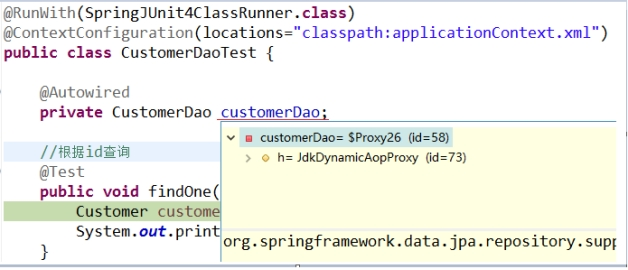
断点执行到方法上时,我们可以发现注入的customerDao对象,本质上是通过JdkDynamicAopProxy生成的一个代理对象
l 代理对象中方法调用的分析
当程序执行的时候,会通过JdkDynamicAopProxy的invoke方法,对customerDao对象生成动态代理对象。根据对Spring Data JPA介绍而知,要想进行findOne查询方法,最终还是会出现JPA规范的API完成操作,那么这些底层代码存在于何处呢?答案很简单,都隐藏在通过JdkDynamicAopProxy生成的动态代理对象当中,而这个动态代理对象就是SimpleJpaRepository

通过SimpleJpaRepository的源码分析,定位到了findOne方法,在此方法中,返回em.find()的返回结果,那么em又是什么呢?

带着问题继续查找em对象,我们发现em就是EntityManager对象,而他是JPA原生的实现方式,所以我们得到结论Spring Data JPA只是对标准JPA操作进行了进一步封装,简化了Dao层代码的开发
5.3 Spring Data JPA完整的调用过程分析
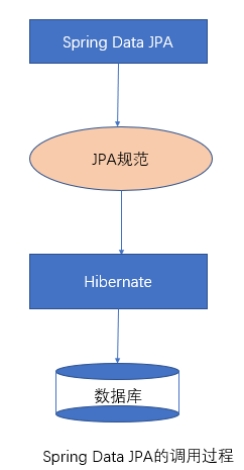
六、Spring Data JPA的查询方式
6.1 使用Spring Data JPA中接口定义的方法进行查询
在继承JpaRepository,和JpaRepository接口后,我们就可以使用接口中定义的方法进行查询
l 继承JpaRepository后的方法列表
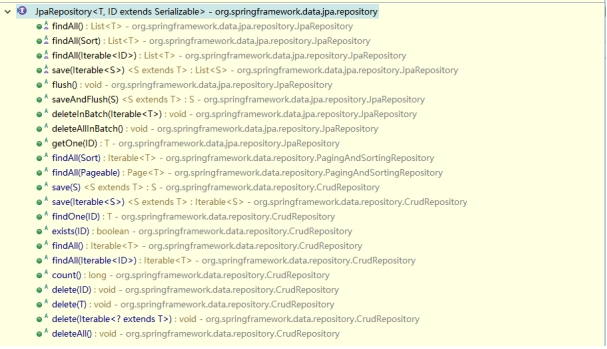
l 继承JpaSpecificationExecutor的方法列表

6.2 使用JPQL的方式查询
完整代码如下:
test/JpqlTest.java
package cn.itcast.test;
import cn.itcast.dao.CustomerDao;
import cn.itcast.domain.Customer;
import org.junit.Test;
import org.junit.runner.RunWith;
import org.springframework.beans.factory.annotation.Autowired;
import org.springframework.data.jpa.repository.Query;
import org.springframework.test.annotation.Rollback;
import org.springframework.test.context.ContextConfiguration;
import org.springframework.test.context.junit4.SpringJUnit4ClassRunner;
import org.springframework.transaction.annotation.Transactional;
import java.util.Arrays;
import java.util.List;
@RunWith(SpringJUnit4ClassRunner.class) //声明spring提供的单元测试环境
@ContextConfiguration(locations = "classpath:applicationContext.xml")//指定spring容器的配置信息
public class JpqlTest {
@Autowired
private CustomerDao customerDao;
@Test
public void testFindJPQL() {
Customer customer = customerDao.findJpql("传智播客");
System.out.println(customer);
}
@Test
public void testFindCustNameAndId() {
// Customer customer = customerDao.findCustNameAndId("传智播客",1l);
Customer customer = customerDao.findCustNameAndId(1l,"传智播客");
System.out.println(customer);
}
/**
* 测试jpql的更新操作
* * springDataJpa中使用jpql完成 更新/删除操作
* * 需要手动添加事务的支持
* * 默认会执行结束之后,回滚事务
* @Rollback : 设置是否自动回滚
* false | true
*/
@Test
@Transactional //添加事务的支持
@Rollback(value = false)
public void testUpdateCustomer() {
customerDao.updateCustomer(4l,"黑马程序员");
}
//测试sql查询
@Test
public void testFindSql() {
List<Object[]> list = customerDao.findSql("传智播客%");
for(Object [] obj : list) {
System.out.println(Arrays.toString(obj));
}
}
//测试方法命名规则的查询
@Test
public void testNaming() {
Customer customer = customerDao.findByCustName("传智播客");
System.out.println(customer);
}
//测试方法命名规则的查询
@Test
public void testFindByCustNameLike() {
List<Customer> list = customerDao.findByCustNameLike("传智播客%");
for (Customer customer : list) {
System.out.println(customer);
}
}
//测试方法命名规则的查询
@Test
public void testFindByCustNameLikeAndCustIndustry() {
Customer customer = customerDao.findByCustNameLikeAndCustIndustry("传智播客1%", "it教育");
System.out.println(customer);
}
}
6.3 使用SQL语句查询
Spring Data JPA同样也支持sql语句的查询,如下:
dao/CustomerDao.java
/**
* nativeQuery : 使用本地sql的方式查询
*/
@Query(value="select * from cst_customer",nativeQuery=true)
public void findSql();
/** * nativeQuery : 使用本地sql的方式查询 */ @Query(value=“select * from cst_customer”,nativeQuery=true) public void findSql();
6.4 方法命名规则查询
顾名思义,方法命名规则查询就是根据方法的名字,就能创建查询。只需要按照Spring Data JPA提供的方法命名规则定义方法的名称,就可以完成查询工作。Spring Data JPA在程序执行的时候会根据方法名称进行解析,并自动生成查询语句进行查询
按照Spring Data JPA 定义的规则,查询方法以findBy开头,涉及条件查询时,条件的属性用条件关键字连接,要注意的是:条件属性首字母需大写。框架在进行方法名解析时,会先把方法名多余的前缀截取掉,然后对剩下部分进行解析。
//方法命名方式查询(根据客户名称查询客户)
public Customer findByCustName(String custName);
具体的关键字,使用方法和生产成SQL如下表所示
| Keyword | Sample | JPQL |
|---|---|---|
| And | findByLastnameAndFirstname | … where x.lastname = ?1 and x.firstname = ?2 |
| Or | findByLastnameOrFirstname | … where x.lastname = ?1 or x.firstname = ?2 |
| Is,Equals | findByFirstnameIs,findByFirstnameEquals | … where x.firstname = ?1 |
| Between | findByStartDateBetween | … where x.startDate between ?1 and ?2 |
| LessThan | findByAgeLessThan | … where x.age < ?1 |
| LessThanEqual | findByAgeLessThanEqual | … where x.age ⇐ ?1 |
| GreaterThan | findByAgeGreaterThan | … where x.age > ?1 |
| GreaterThanEqual | findByAgeGreaterThanEqual | … where x.age >= ?1 |
| After | findByStartDateAfter | … where x.startDate > ?1 |
| Before | findByStartDateBefore | … where x.startDate < ?1 |
| IsNull | findByAgeIsNull | … where x.age is null |
| IsNotNull,NotNull | findByAge(Is)NotNull | … where x.age not null |
| Like | findByFirstnameLike | … where x.firstname like ?1 |
| NotLike | findByFirstnameNotLike | … where x.firstname not like ?1 |
| StartingWith | findByFirstnameStartingWith | … where x.firstname like ?1 (parameter bound with appended %) |
| EndingWith | findByFirstnameEndingWith | … where x.firstname like ?1 (parameter bound with prepended %) |
| Containing | findByFirstnameContaining | … where x.firstname like ?1 (parameter bound wrapped in %) |
| OrderBy | findByAgeOrderByLastnameDesc | … where x.age = ?1 order by x.lastname desc |
| Not | findByLastnameNot | … where x.lastname <> ?1 |
| In | findByAgeIn(Collection ages) | … where x.age in ?1 |
| NotIn | findByAgeNotIn(Collection age) | … where x.age not in ?1 |
| TRUE | findByActiveTrue() | … where x.active = true |
| FALSE | findByActiveFalse() | … where x.active = false |
| IgnoreCase | findByFirstnameIgnoreCase | … where UPPER(x.firstame) = UPPER(?1) |
